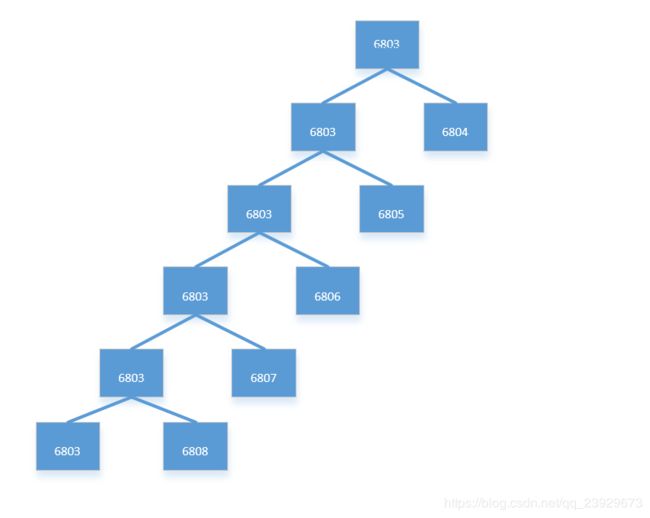C语言多进程编程
文章目录
- 一、进程简介
- 二、创建进程fork()
- 1、头文件
- 2、函数原型
- 3、返回值
- 4、注意点
- 5、vfork()函数
- 三、举例
- 四、代码剖析
- 五、父子进程开始执行的位置
一、进程简介
1、进程是程序的执行。程序是静态的,进程是动态的。
2、进程在内存中有三部分组成:数据段、堆栈段和代码段。
代码段:就是存放程序代码的数据,如果有数个进程运行同一个一个程序,那么它们就可以使用同一个代码段(代码段是可以共享的);
堆栈段:存放的是子程序的返回地址、参数以及程序的局部变量,主要是保存进程的执行的环境,这里用到了栈先进后出的特性,可以看做具有记忆上一次执行的环境。
数据段:存放程序的全局变量 、常数
3、动态数据分配的数据空间
系统如果同时运行数个相同的程序,它们之间就不能使用同一个堆栈段和数据段,但是可以使用同一个代码段(代码段是可以共享的)
4、lwp:
线程ID。在用户态的命令(比如ps)中常用的显示方式。
二、创建进程fork()
1、头文件
#include
#include
2、函数原型
pid_t fork( void);
pid_t 是一个宏定义
3、返回值
若成功调用一次则返回两个值,子进程返回0,父进程返回子进程ID;否则,出错返回-1
4、注意点
a、在Linux系统中创建进程有两种方式:一是由操作系统创建,二是由父进程创建进程(通常为子进程)。系统调用函数fork()是创建一个新进程的唯一方式,当然vfork()也可以创建进程,但是实际上其还是调用了fork()函数。fork()函数是Linux系统中一个比较特殊的函数,其一次调用会有两个返回值。
b、调用fork()之后,父进程与子进程的执行顺序是我们无法确定的(即调度进程使用CPU),意识到这一点极为重要,因为在一些设计不好的程序中会导致资源竞争,从而出现不可预知的问题。
c、fork产生子进程的表现就是它会返回2次,一次返回0,顺序执行下面的代码。这是子进程。一次返回子进程的pid,也顺序执行下面的代码,这是父进程。
d、进程创建成功之后,父进程以及子进程都从fork() 之后开始执行,只是pid不同。fork语句可以看成将程序切为A、B两个部分。(在fork()成功之后,子进程获取到了父进程的所有变量、环境变量、程序计数器的当前空间和值)。
e、一般来说,fork()成功之后,父进程与子进程的执行顺序是不确定的。这取决于内核所使用的调度算法,如果要求父子进程相互同步,则要求某种形式的进程间通信。
5、vfork()函数
也用于创建一个进程,返回值与fork()相同。
fork()与vfork()的异同
执行次序:
a、fork():对父子进程的调度室由调度器决定的;
b、vfork():是先调用子进程,等子进程的exit(1)被调用后,再调用父进程;
对数据段的影响:
a、fork():父子进程不共享一段地址空间,修改子进程,父进程的内容并不会受影响。
b、vfork():在子进程调用exit之前,它在父进程的空间中运行,也就是说会更改 父进程的数据段、栈和堆。。即共享代码区和数据区,且地址和内容都是一 样的。
三、举例
#include
#include
#include
#include
#include
#include
#include
using namespace std;
// 进程退出函数
void print_exit()
{
printf("the exit pid:[%d] \n",getpid() );
}
int main()
{
string sMatch;
pid_t pid, child_pid;
vector provList;
provList.push_back("taskFace");
provList.push_back("taskObj");
provList.push_back("taskAction");
provList.push_back("taskHat");
provList.push_back("taskOther");
cout << "Main process,id=" << getpid() << endl;
// 循环处理"100,200,300,400,500"
for (vector::iterator it = provList.begin(); it != provList.end(); ++it)
{
sMatch = *it;
atexit( print_exit );
pid = fork();
// (*hsq*)子进程退出循环,不再创建子进程,全部由主进程创建子进程,这里是关键所在
if(pid == 0 || pid == -1)
{
break;
}
}
if(pid == -1)
{
cout<<"Fail to fork!"< 四、代码剖析
执行结果如下:
Main process,id=6803
This is children process,id=6804,start to process taskFace
This is children process,id=6805,start to process taskObj
This is main process,id=6803,end to process taskOther
This is children process,id=6806,start to process taskAction
I am main progress.The pid progress has not exited!
This is children process,id=6807,start to process taskHat
This is children process,id=6808,start to process taskOther
I am main progress.The pid progress has not exited!
I am main progress.The pid progress has not exited!
I am main progress.The pid progress has not exited!
I am main progress.The pid progress has not exited!
the exit pid:[6804]
the exit pid:[6806]
the exit pid:[6805]
the exit pid:[6806]
the exit pid:[6806]
the exit pid:[6805]
the exit pid:[6807]
the exit pid:[6807]
the exit pid:[6807]
the exit pid:[6807]
the exit pid:[6808]
the exit pid:[6808]
the exit pid:[6808]
the exit pid:[6808]
the exit pid:[6808]
I am main progress.The pid progress has not exited!
the exit pid:[6803]
the exit pid:[6803]
the exit pid:[6803]
the exit pid:[6803]
the exit pid:[6803]
从结果可以看出,子进程函数中
6804:退出了一次
6805:退出了两次
6806:退出了三次
6807:退出了四次
6808:退出了五次
主进程
6803退出了五次
下面解释一下出现这种问题的主要原因:
1、为什么会出现
6804:退出了一次
6805:退出了两次
6806:退出了三次
6807:退出了四次
6808:退出了五次
的现象
答:因为最下面的6808相当于被fork了5次,后续各个子进程开出的进程发现进程id已经存在,则不会重复创建新的进程,所以各个子进程执行任务只执行一次,但是退出的时候却退出了5次。
2、主进程为什么退出了五次
the exit pid:[6803]
the exit pid:[6803]
the exit pid:[6803]
the exit pid:[6803]
the exit pid:[6803]
答:每个子进程都会开一个新的主进程和子进程。所以会出现主进程退出5次的现象。主进程不会附加标签,但是每个fork的子进程会附加标签

五、父子进程开始执行的位置
#include
#include
main ()
{
pid_t pid;
printf("hello!\n");
pid=fork();
if (pid < 0)
printf("error in fork!");
else if (pid == 0)
printf("i am the child process, my process id is %d\n ",getpid());
else
printf("i am the parent process, my process id is %d\n",getpid());
printf("bye!\n");
}
这里可以看出parent process执行了printf(“hello!\n”); 而child process 没有执行printf(“hello!\n”);
有一个让人很迷惑的例子:
#include
#include
main ()
{
pid_t pid;
printf("fork!"); //printf("fork!\n")
pid=fork();
if (pid < 0)
printf("error in fork!\n");
else if (pid == 0)
printf("i am the child process, my process id is %d\n",getpid());
else
printf("i am the parent process, my process id is %d\n",getpid());
}
此时打印输出了两个fork!这不免让人以为是child process从#include处开始执行,所以也执行了printf(“fork!”); 语句。
其实不然,出现这种问题的原因在于:
这就跟Printf的缓冲机制有关了,printf某些内容时,操作系统仅仅是把该内容放到了stdout的缓冲队列里了,并没有实际的写到屏幕上 。但是,只要看到有\n, 则会立即刷新stdout,因此就马上能够打印了.mian函数(parent process)运行了printf(“fork!”) 后, “fork!”仅仅被放到了缓冲里,再运行到fork时,缓冲里面的 AAAAAA 被子进程(child process)继承了,因此在子进程度stdout缓冲里面就也有了”fork!”。所以,你最终看到的会是 “fork!” 被printf了2次!!! 而mian函数(parent process)运行 printf(“fork!\n”)后,”fork!” 被立即打印到了屏幕上,之后fork到的子进程(child process)里的stdout缓冲里不会有”fork!”内容 因此你看到的结果会是”fork!” 被printf了1次!!!